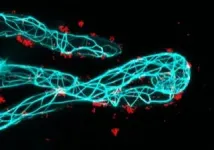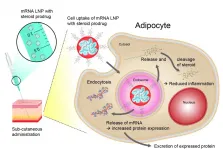(Press-News.org) Scientists are warning that drinking water supplies in parts of rural West Africa are being contaminated by lead-containing materials used in small community water systems such as boreholes with handpumps and public taps.
They analysed scrapings taken from the plumbing of 61 community water supply systems in Ghana, Mali and Niger. Eighty percent of the tested systems had at least one component that contained lead in excess of international guidance.
Lead is released into the water when the components corrode.
The study, by a research team from the University of Leeds, University of North Carolina at Chapel Hill and Boston University, also took samples of the water from those 61 water distribution systems, and from a further 200 taps and boreholes with handpumps.
Sixty percent of the samples contained lead - nine percent were at a level that exceeded World Health Organisation guidelines.
The researchers found that lead contamination was significantly associated with the use of lead-containing components in the water systems.
There is no-known safe level of exposure to lead. It accumulates in the body and crosses the blood-brain barrier and can cause irreversible damage to cognitive and neurological development, particularly in children and babies in the womb.
Lead contamination in plumbing systems has been a recognised problem for decades which has been controlled in urban areas served by large piped water systems by implementing corrosion control and using lead-free or low-lead components, enforced through testing and monitoring, building codes and regulations.
Evidence shows there is still a problem in higher-income countries with lead contamination in water from private wells and small, piped systems. The picture in low and middle-income countries has been less well studied, although the problem is believed to be widespread - and the potential implications for public health are much greater because of the global scale and the number of people who rely on small community water-supply systems.
In Sub-Sharan Africa alone, it is estimated that 184 million people use boreholes with handpumps to access water and 112 million people use rural piped supplies.
'Opportunity for effective prevention'
Jamie Bartram, Professor of Public Health and Environment at the University of Leeds, who supervised the latest research, said the evidence demonstrated the need for coordinated and urgent remedial action.
"We have an opportunity for effective prevention and improved water supply practice world-wide. The required actions are overdue and unquestionably beneficial. The cost of ensuring that components are lead-safe is negligible," he said.
"Using certified-safe components has multiple benefits, minimizing the risk to other hazardous contaminants. In contrast, delay carries further disease burden, increases the ultimate cost of protecting populations, and accumulates remediation burdens for future generations."
The study, Occurrence of Lead and other Toxic Metals Derived from Drinking-Water Systems in three West African Countries, is published in the journal Environmental Health Perspectives.
The International Plumbing Code (IPC), from the International Code Council, recommends that lead in a plumbing component should not exceed 0.25 percent, based on weight.
Of the 130 plumbing components tested by the research team, 82 percent had a lead level that exceeded the IPC recommended maximum. Brass components were the most problematic. The researchers say the use of brass in a water system increased the expected lead concentrations in drinking-water samples by a factor of 3.8.
Where drinking water was contaminated, the mean value of lead in the water was approximately 8 micrograms in a litre of water - where a microgram is one-millionth of a gram. The individual values, the 95 percent confidence limit, ranged from 0.5 micrograms/litre of water to 15 micrograms/litre of water. The World Health Organisation guideline value is 10 micrograms/litre of water.
Dr Michael Fisher, Assistant Professor at the University of North Carolina at Chapel Hill, led the study. He said: "It is clear is that lead is present in most tested systems in this study and finds its way into drinking water at levels of concern.
"These findings suggest several affordable, feasible, no-regrets opportunities to reduce or prevent this contamination from occurring. Collaboration among multiple stakeholders will be required to achieve rapid success.
"Lead exposure from other sources like paint and petrol has been successfully phased out and lead can be successfully eliminated from drinking water systems through concerted and collaborative responses."
Need for coordinated action
The scientists say manufacturers could discourage the use of unsuitable components, for example through explicit labelling and engagement in professional networks.
They write in the paper: "This contamination may be readily addressed through cost-effective preventive action, such as consistent use of components and materials compliant with IPC codes. Supply chain improvements with verification of compliance would reduce the availability and use of unsuitable components, such as leaded brass parts, in drinking-water systems.
"Governments may develop or update regulations related to lead-free water system components and their implementation, including verification schemes."
The research team say importers and wholesalers should ensure that product suitability and specifications are conspicuous and intelligible. Professional associations should disseminate knowledge and foster understanding and good practices throughout their memberships. Several governments are already taking action.
The United Nations Sustainable Development Goal SDG 6 states that everybody should have access to safe and affordable drinking water.
INFORMATION:
The research was funded by World Vision, an NGO that works to reduce poverty affecting children.
Migratory waterbirds are particularly exposed to the effects of climate change at their breeding areas in the High Arctic and in Africa, according to a new study published in Bird Conservation International. The research team came to this conclusion after modelling climatic and hydrological conditions under current and future climate scenarios (in 2050) and comparing the impact on the distribution of 197 of the 255 waterbird species listed under the Agreement on the Conservation of African-Eurasian Migratory Waterbirds (AEWA). The international team was led by Wetlands International, BirdLife International, and the British Trust for Ornithology, involved researchers from various universities, including McGill. The results suggest that investing more in habitat conservation in the wider ...
A team of researchers led by Nanyang Technological University, Singapore (NTU Singapore) has developed a device that offers a quicker and less invasive way to seal tears and holes in blood vessels, using an electrically-activated glue patch applied via a minimally invasive balloon catheter.
This device could eventually replace the need for open or keyhole surgery to patch up or stitch together internal blood vessel defects.
After inserting the catheter into an appropriate blood vessel, the glue patch - nicknamed 'Voltaglue' - can be guided through the body to where the tear is located and then activated using retractable electrodes to glue it shut in ...
Symptoms of health anxiety are common already during childhood and adolescence - and if the children do not receive the correct help, the anxiety can become a permanent problem with serious personal and socio-economic consequences. This is shown by a new research result from Aarhus University and the University of Copenhagen.
Ida is 11 years old. Six months ago, her grandmother died of cancer after a long illness and since then Ida has become more and more anxious that she too will get cancer and die. The anxiety can be triggered when she passes by a hospital or sees people who look ill. ...
What would it be like to produce fertilizer in your own basement? Leguminous plants, like peas, beans, and various species of clover, obtain the organic nitrogen they need for their growth from symbiotic soil bacteria via specialized structures in their roots. A team led by the cell biologist Prof. Dr. Thomas Ott from the University of Freiburg's Faculty of Biology has now detected a factor in the root cells that the plants need for the initial contact with these so-called root-associated bacteria, which live in the soil. They discovered a protein found only in legumes called symbiotic formin 1 (SYFO1) and demonstrated the essential role it plays in symbiosis. Together with the molecular biologist Prof. Dr. Robert Grosse University of Freiburg's Faculty of Medicine and the evolutionary ...
In a number of biological processes, iron-sulfur clusters play a vital role, where they act as cofactors to enzymes. Research published in Angewandte Chemie now shows that cubic clusters can support unusual bonding states. This study shows that the cluster copes well with a multiple bond between iron and nitrogen--a structural motif that may be involved in biological nitrogen fixation.
Clusters made of iron and sulfur atoms are essential cofactors for a number of enzymes, especially in biological processes involving electron transfer. As an example, nitrogen-fixing bacteria use iron-sulfur clusters to convert ...
An international team of scientists from 20 countries identified 47 problems that hinder the successful prevention and elimination of the consequences of the tsunami. Based on the carried out analysis, the world's leading experts on natural hazards have outlined directions for further scientific research. The research group's review is published in a special issue of the "Frontiers in Earth Science".
The main problems identified in the review are related to the large gaps and uncertainties in knowledge about tsunami, the lack of well-documented observations, and imperfect methods of processing available information. One of the reasons is the lack of coordination of the efforts of those countries for which the study and prediction of tsunamis, forecasting the corresponding risks, and preparation ...
Berlin, 3 May - In a new report, ALLEA, the European Federation of Academies of Sciences and Humanities, examines the potential of technical and policy measures to tackle science disinformation and calls for improved European exchange and coordination in this field.
While disinformation strategies are intoxicating public discourses in many fields, science disinformation is particularly dangerous to democratic governance and society at large. As highlighted by the ongoing pandemic, an undermining of trust in science poses a fundamental threat to political and individual decisions based on evidence and scientific knowledge.
Over ...
Impaired bone health is among the most significant long-term consequences of hematopoietic stem cell transplantation (HSCT), a common therapy for patients with malignant and non-malignant haematological diseases.
To address this serious problem, the International Osteoporosis Foundation (IOF) expert Working Group on Cancer and Bone Disease has published a new Executive Summary of its authoritative state-of-the-art review. The review outlined the major factors affecting bone health in HSCT patients, and provided expert guidance for the monitoring, evaluation and treatment of bone loss in these patients. ...
Globally, tuberculosis is the most common bacterial infectious disease leading to death. The pathogen causing tuberculosis, Mycobacterium tuberculosis, has a number of peculiarities. One is that it is growing very slowly. While other typical pathogens, such as pneumococcal and pseudomonads, can already be identified by their growth in the microbiological laboratory in the first 72 hours, several weeks usually pass before tuberculosis bacteria grow in the lab. Thus it often takes one to two months before the efficacy of individual medicines can be tested.
However, these efficacy tests are essential for the effective treatment of multidrug-resistant tuberculosis (MDR-TB), which is becoming increasingly common. In these cases, the pathogen has become ...
If not before, then certainly since the first messenger RNA (mRNA) vaccines to combat the SARS CoV2 virus were approved in Germany, mRNA has become a recognized term even outside scientific circles. What is less well known is that mRNA can be used to produce much more than just vaccines. Around 50 different procedures for the treatment of diseases including cancer are already being studied in clinical trials. Scientists from the pharmaceutical company AstraZeneca, with the support of neutron researchers from Forschungszentrum Jülich, have now discovered how the subcutaneous administration of mRNA can be improved. The goal is for chronically ill ...




